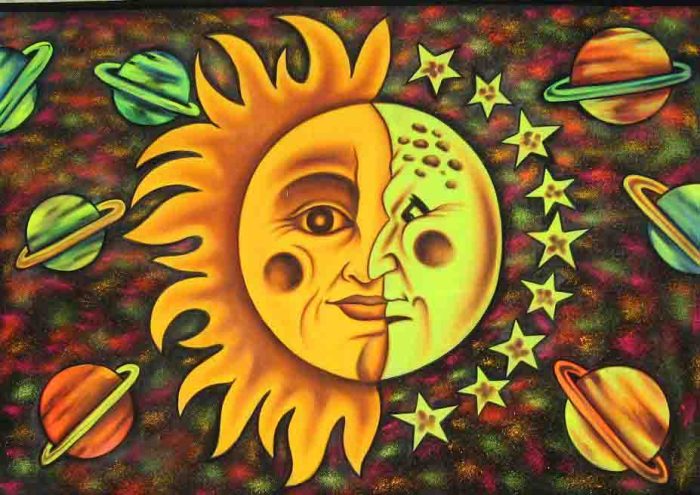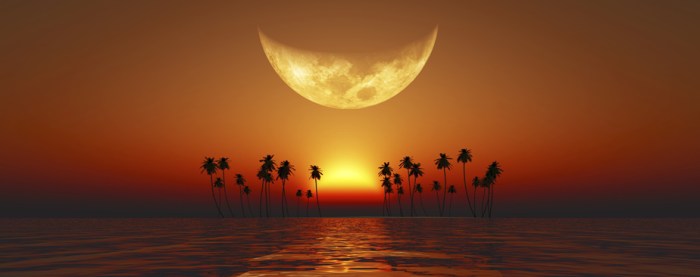Sun and the moon together – Sun and Moon: A Cosmic Union of Symbolism and Science sets the stage for this enthralling narrative, offering readers a glimpse into a story that is rich in detail and brimming with originality from the outset. From their symbolic representation in cultures worldwide to their scientific relationship in astronomy, the sun and moon have captivated the human imagination for centuries.
This comprehensive exploration delves into the intricate interplay between these celestial bodies, unveiling their profound impact on art, literature, culture, and society. Prepare to embark on a journey that illuminates the sun and moon’s enduring legacy, revealing their significance in shaping our understanding of the universe and ourselves.
Symbolism and Mythology

The sun and moon, celestial bodies of immense power and beauty, have captivated human imagination since time immemorial. In cultures across the globe, they have been revered as symbols of life, fertility, and the passage of time.Throughout mythology and folklore, the sun and moon are often depicted as deities or supernatural beings.
In ancient Egyptian mythology, the sun god Ra was believed to sail across the sky in his solar barge, while the moon god Khonsu represented time and healing. In Greek mythology, Helios was the personification of the sun, and Selene embodied the moon.
Native American traditions often associate the sun with the masculine principle and the moon with the feminine principle.The symbolism of the sun and moon extends beyond their celestial significance. In literature and art, they frequently represent contrasting forces or aspects of human nature.
The sun, with its radiant light and warmth, often symbolizes knowledge, enlightenment, and masculine energy. The moon, on the other hand, with its enigmatic glow and cyclical nature, represents mystery, intuition, and feminine energy.
Sun Symbolism
- Light, warmth, and life
- Knowledge, enlightenment, and truth
- Masculine energy, power, and strength
- Vitality, growth, and abundance
- The conscious mind and rational thought
Moon Symbolism, Sun and the moon together
- Darkness, mystery, and the unknown
- Intuition, imagination, and creativity
- Feminine energy, receptivity, and compassion
- Cycles, change, and transformation
- The subconscious mind and emotional realm
Astronomy and Science: Sun And The Moon Together

The sun and moon, two celestial bodies that have captivated human imagination for centuries, share a profound scientific relationship that governs their movements and interactions within our solar system.
The sun, a massive ball of incandescent gas, is the center of our solar system, emitting vast amounts of light and heat that sustain life on Earth. The moon, on the other hand, is a rocky, airless satellite that orbits Earth, reflecting sunlight back to our planet.
Orbital Patterns
The sun and moon engage in intricate orbital patterns around each other. The moon orbits Earth in an elliptical path, taking approximately 27.3 days to complete one revolution. Earth, in turn, orbits the sun in a nearly circular path, completing one orbit in approximately 365.25 days.
Gravitational Interactions
The gravitational force exerted by the sun and moon on each other is responsible for their orbital patterns and interactions. The sun’s immense gravitational pull keeps Earth in orbit, while Earth’s gravitational pull keeps the moon in orbit around itself.
The sun and moon, celestial bodies that dance across the cosmic tapestry, have inspired awe and wonder throughout human history. To delve deeper into the intricate workings of our government, consider exploring the ap gov unit 1 flashcards . These flashcards offer a comprehensive overview of foundational concepts, empowering you to navigate the complexities of governance.
As the sun sets and the moon rises, illuminating the night, may your understanding of our political system soar.
Impact on Tides and Eclipses
The combined gravitational effects of the sun and moon on Earth’s oceans give rise to tides. The moon’s gravitational pull on Earth’s water causes it to bulge out on the side facing the moon, creating high tide. The sun’s gravitational pull also contributes to tides, but to a lesser extent.
Eclipses occur when the sun, moon, and Earth align in a specific way. A solar eclipse occurs when the moon passes directly between the sun and Earth, blocking out the sun’s light. A lunar eclipse occurs when Earth passes directly between the sun and moon, blocking the sun’s light from reaching the moon.
Art and Literature

The sun and moon have inspired countless works of art and literature throughout history. From the ancient Egyptians to the modern day, artists and writers have used these celestial bodies to evoke emotions, convey themes, and explore the human condition.
Paintings and Sculptures
- In paintings, the sun is often depicted as a source of light and warmth, while the moon is associated with mystery and the unknown. For example, in Vincent van Gogh’s “Starry Night,” the swirling sky and bright stars represent the sun’s power and energy, while the dark, crescent moon adds a sense of intrigue and foreboding.
- In sculptures, the sun and moon are often used to symbolize the passage of time and the cyclical nature of life. For example, in the ancient Egyptian temple of Karnak, there are statues of the sun god Ra and the moon god Khonsu, which represent the daily and monthly cycles of the sun and moon.
Poetry and Prose
- In poetry, the sun and moon are often used as metaphors for love, hope, and renewal. For example, in William Blake’s poem “The Tyger,” the sun is described as “burning bright,” representing the power and passion of love. In contrast, the moon is described as “pale and cold,” representing the mystery and uncertainty of love.
- In prose, the sun and moon are often used to create a sense of atmosphere and mood. For example, in Ernest Hemingway’s novel “The Old Man and the Sea,” the sun’s relentless heat and glare create a sense of oppression and despair, while the moon’s gentle glow provides a sense of hope and solace.
Drama
- In drama, the sun and moon are often used to symbolize the forces of good and evil. For example, in Shakespeare’s play “Macbeth,” the sun is associated with the forces of good, while the moon is associated with the forces of evil.
The play’s protagonist, Macbeth, is torn between the two forces, and his ultimate downfall is symbolized by the eclipse of the sun.
Culture and Society

The sun and moon hold immense cultural significance across various societies worldwide. They have played a pivotal role in shaping festivals, rituals, and traditions.
Festivals and Rituals
Many cultures celebrate the sun and moon through festivals and rituals. For instance, the Chinese Mid-Autumn Festival honors the full moon and symbolizes family reunions. In ancient Egypt, the Sun Festival marked the summer solstice and celebrated the sun god Ra.
Calendars and Timekeeping
The sun and moon have influenced the development of calendars and timekeeping systems. The solar calendar, based on the Earth’s orbit around the sun, is widely used today. The lunar calendar, based on the moon’s phases, is still employed in some cultures for religious or agricultural purposes.
Navigation
Throughout history, the sun and moon have served as navigational aids for travelers and seafarers. Sailors used the sun’s position to determine their latitude, while the moon’s phases helped them estimate the time and tide.
Essential Questionnaire
What is the scientific relationship between the sun and moon?
The sun is a star, while the moon is a natural satellite that orbits the Earth. The moon’s gravity exerts a tidal force on Earth, causing the ocean tides. The sun’s gravity also influences the moon’s orbit and causes eclipses.
How have the sun and moon been depicted in art and literature?
The sun and moon have been depicted in art and literature for centuries, often as symbols of opposing forces or as representations of divine beings. In paintings, sculptures, and photography, they have been used to evoke emotions and convey themes.
In poetry, prose, and drama, they have been used as metaphors and symbols to explore human experiences.
What is the cultural significance of the sun and moon in different societies?
The sun and moon have played a significant role in the development of human cultures. They have been used to mark time, create calendars, and navigate the seas. They have also been associated with religious beliefs and rituals, and have been seen as symbols of power, fertility, and renewal.